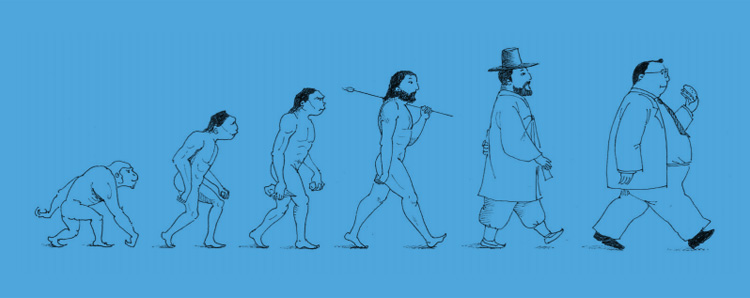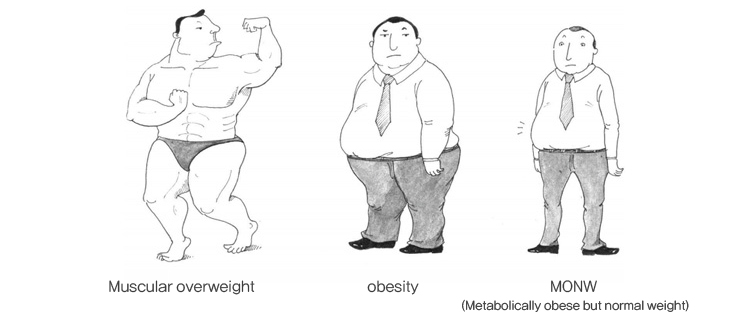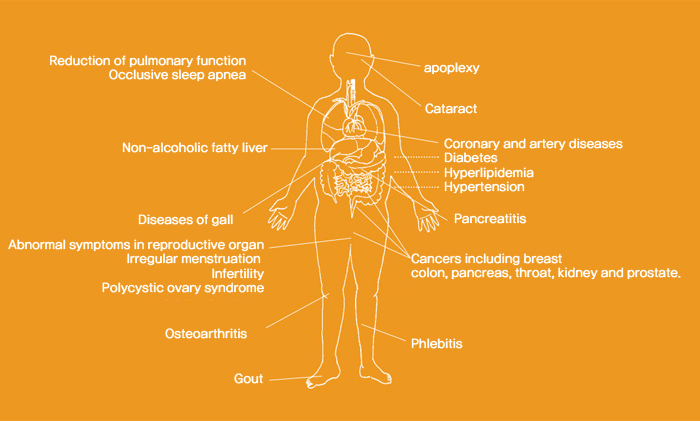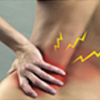Home > R&D > Obesity




We need to find out what defines obesity before we endeavor to improve understanding, treatment and prevention of obesity. The precise definition on obesity is “excess body fat that is accumulated in the bodyâ€. Obesity is accurately examined not by weight but by excess body fat accumulated in the body. A variety of intestines and organs exist in the body including adipose tissues, muscles, bones, liver, kidney, lung, heart and blood.
Talking about obesity in terms of only being overweight ignores the weight of organs and may cause misunderstandings about obesity. For example, bodybuilders may be heavy, but when their body configuration is analyzed they have low body fat and high muscle quantity. In terms of weight, bodybuilders may be misunderstood as obese patients, but they are not considered to be obese in terms of body fat. Since obesity is defined by excess body fat, it is determined on the basis of body fat. Another example are people with a high body fat ratio in body composition even though their weight is not heavy. They need to be considered as the obese patients (so called “MONW (metabolically obese but normal weightâ€) because of high risk to have obesity-related diseases (including diabetes and dyslipidemia).


Obesity is the source of all kinds of diseases. Increasing body fat causes a variety of diseases. The major diseases related to obesity include type II diabetes mellitus, dyslipidemia, hypertension, fatty liver, diseases related to gall, coronary artery diseases (angina and cardiac infarction), sleep apnea, gout, osteoarthritis, irregular menstruation, colon, breast or ovarian cancer.
The same complications can occur in obese children. When obese children age and remain obese, they may suffer from any of diseases above at a relatively young age. It is important to manage obesity earlier. Obesity is accompanied with psychological diseases as well as physical diseases.


When losing weight, it is known that exercise reduces the loss of muscle quantity and helps to maintain weight loss in the long term. However, it is also known that controlling weight by exercise alone reduced weight only by 0.1 kg per week without concurrent dietary treatment. It is important to control food intake to reduce weight. The amount of weight lost by exercise varies on gender. Exercise is more effective for men than women.
A number of studies identified the effect of aerobic exercise on controlling weight. However, there are fewer studies on the effect of strength training on controlling weight. While strength training has less impact on losing weight while reducing caloric intake, it reduces the loss of muscle quantity. Thus, it is more effective for controlling weight to combine exercise and dietary treatment rather than to do only dietary treatment.

However, it was identified that those who exercise as well as excessively reduce the quantity of food don’t lose significantly more weight than those who do not exercise during dietary treatment. It isn’t necessary to excessively reduce the quantity of food when controlling weight with both dietary treatment and exercise together for health.
In accordance with the data presented by the American Medical Society for Sports Medicine, the minimum exercise requirement for preventing weight from increasing is walking for more than 150 minutes a week. Those who are obese or overweight need to walk for about 150 to 250 minutes a week to lose weight and those who successfully lost weight and need maintain it need to walk for more than 250 minutes a week. Therefore, exercise can’t be reduced even after achieving the target weight.
The following activities will increase daily movement and greatly help to control weight: making time for exercise despite a busy schedule, reducing time for watching TV or using computer, using stairs instead of elevators, walking a short distance, using public transportation rather than driving a car, and increasing the amount of daily walking by parking relatively far away from the workplace.
t is also good to monitor oneself by measuring daily physical activity using a pedometer, showing the amount of steps in a day, or an accelerometer, showing the amount of movement in a day.
Excessive exercise or dietary control may be harmful to health. When exercising for controlling weight, it is necessary to set the proper goal step by step and to do exercise suitable for physical conditions. Those who are overweight or obese should refrain from strenuous exercise which may be a burden to joints and exercise in such a way as to gradually increase the difficulty and duration of exercise.

It is required to reduce calorie intake and increase energy consumption to lose weight. Reducing 500 kcal per day reduces weight by about 0.5 kg per week. Severe calorie restriction may significantly reduce weight but be less effective in the long term because weight can be restored easily.
Excessive intake of carbohydrates increases calorie intake and the neutral fat level in blood. Thus, it is better to prevent excessive intake of carbohydrates and to have complex carbohydrates (including brown rice, whole grains, whole wheat) rather than simple carbohydrates (including sugar, honey, jam and other sweet food).

It is necessary to restrict fat, especially saturated fat and trans fat because they are high in calories and they increase the risk of cardiovascular diseases which are frequently found in obese patients. It is also not good to have too much vegetable oil.
Saturated Fat: beef tallow, lard, butter and others.
Trans Fat: shortening, margarine, processed chocolate and others.
Protein is necessary to produce the substances required in our body including muscles, antibodies and hormones and so it needs to be properly taken. In particular, be careful to prevent insufficiency of protein because proteolysis increases when reducing calorie intake for controlling weight.
Dietary fiber, vitamins, minerals and water need to be sufficiently taken. Liquors need to be restricted when controlling weight because they may increase weight by increasing intake of high calorie food.
Slow and regular meals help to control the amount of food intake. In particular, having too many snacks may increase calorie intake and have a negative impact on the habit of eating meals.
There are a variety of approaches to control weight. However, most of them do not properly verify the effects.
Furthermore, they reduce weight but sometimes cause bad effects on health due to the nutritional problems. It is important to be cautious when selecting from diverse kinds of approaches for controlling weight.

When eating fish or meat, select the parts with less fat. Have seafood, the low-fat food, more frequently. Use only a small amount of oil, and when possible cook with water without frying or stir-frying with oil.
Allowed Food : vegetables, sea mustard, kelp (not fried), laver (not baked with oil), mushrooms, unsweetened tea, water
Food to restrict : fatty meat, fried food, salted seafood, fried noodles, too sweet food, soda drinks, cookies, instant food, liquors, nuts, walnuts, pine nuts, dressings.
| 구분 | Food | Materials | Serving Size |
|---|---|---|---|
| Morning | Clear white radish soup | Clear white radish soup | 1 bowl |
| Steamed egg casserole | Egg | 1 egg | |
| Seasoned Zucchini | Zucchini | 1 plate | |
| Seasoned spinach | Spinach | 1 plate | |
| Lunch | Barley rice | Barley and rice | 1/2 bowl |
| Tofu in bean paste soup | Tofu in bean paste soup | 1 bowl | |
| Fried baby octopus | Baby octopus | 1 plate | |
| Leafy vegetables | Leafy vegetables | 2 plates | |
| Bean paste sauce | Bean paste sauce | 1 tsp | |
| Dinner | Black rice | Black rice | 1/2 bowl |
| Sea mustard soup | Sea mustard soup | 1 bowl | |
| Grilled Spanish mackerel | Spanish mackerel | 1 piece | |
| Shredded and seasoned white radish | White radish | 1 plate | |
| Seasoned sesame leaves | Sesame leaves | 1 plate | |
| Snacks | Low fat milk | Low fat milk | 1 cup |
| Peach | Peach (medium size) | 1Peach |


Ultrasonic wave is the wavelength of sound. The vibration rate (sound level) means the number of vibrations per second. It is called frequency. Hertz (Hz) is the frequency unit. It is the audible sound which people can hear and its range is from 40 Hz to 20,000 Hz. The sound wave exceeding the frequency rate of about 20,000 Hz (20 KHz) is called ultrasonic wave. The ultrasonic wave is a sound which people can’t hear. It vibrates over 20,000 times per second. Put a drop of water on an ultrasonic wave, and it finely vibrates due to the vibration of the ultrasonic wave.

Ultrasonic wave has been applied safely in various ways for a number of purposes including ultrasonic diagnosis system, ultrasonic measuring equipment, ultrasonic washing machines and ultrasonic humidifiers in daily life. Ultrasonic wave works by sound, not by electric stimulation when penetrating into skin. It is safe for skin application without any harm. Ultrasonic wave activates or decomposes cells which become older or degraded by making them dynamically work to penetrate deeply into a human body quickly before we can recognize the wave.


- â‘ Vibration of 1 million times per second relaxes knotted muscles and exchange fluid running in a body.
- â‘، Micro massage reaching to the cell unit relaxes muscles and activates skin.


- â‘ Ultrasonic massage induces a deep cleansing effect.
- â‘، Ultrasonic wave clarifies skin complexion by clearing dead cells, dust, or cosmetic remnants on skin surface or wastes from pores.


- ①Vibration is generated as cells massage each other by micro massage. Temperature increases by about 0.5℃.
- â‘، Blood and lympathic circulation increases as metabolism is accelreated on the massage areas.


- â‘ Fine vibration by ultrasonic wave relieves pain by relaxing muscles.


Low frequency is opposite to high frequency in accordance with the classification of electromagnetic wave by frequency. It is generally below 10 kHz. It is not harmful to human bodies. Low frequency therapy reduces the size of a cell as it directly acts on and shakes the muscular cells or fat cells which are excessively fertilized in a body. Low frequency enhances resilience of muscles by repeating the exercise which shrinks and twists muscles.




Heating is very important for health. Hippocrates, the father of medicine, said “patients which can’t be treated by medicine can be treated by surgical operation and the patients which can’t be treated by surgical operation can be treated by heat. The patients which can’t be treated by heat are terminally illâ€.
Heat is a kind of energy. When the internal energy contained in an object is physically changed, the change is partially or completely emitted as heat. Medical thermotherapy uses heat to produce this phenomenon.
Thermotherapy works according to the principle that when the temperature of tissues increases as heat is applied to a body, metabolism accelerates, blood vessels expand and the blood circulation accelerates.
The main purpose for applying heat to a human body is accelerating the blood flow by increasing temperature. The cells in our body are most active at 36.5℃. Even if body temperature drops only by 1℃, people suffer from a variety of diseases. When body temperature goes up only by 1℃, people become drowsy and less active.
As described above, the internal temperature inside the body is the most important element determining life or death.























































